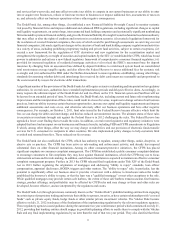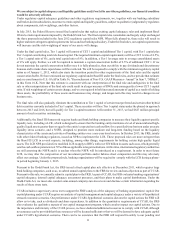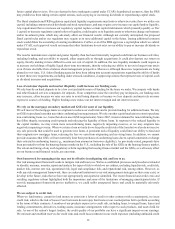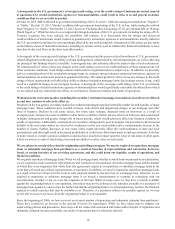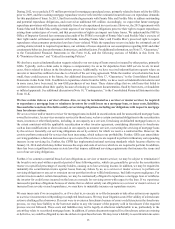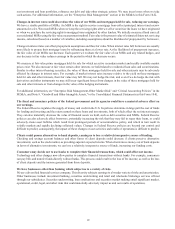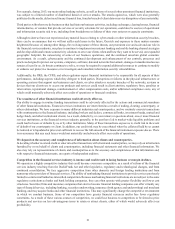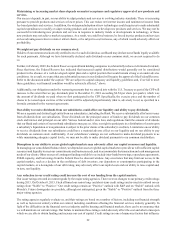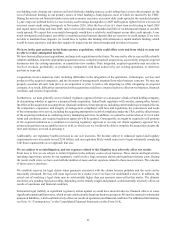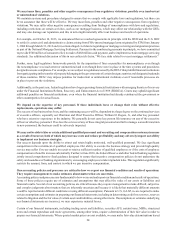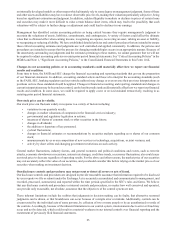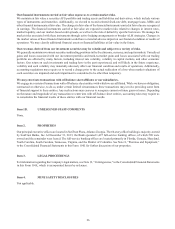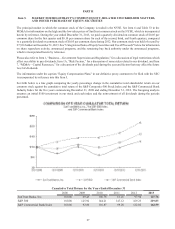SunTrust 2013 Annual Report Download - page 35
Download and view the complete annual report
Please find page 35 of the 2013 SunTrust annual report below. You can navigate through the pages in the report by either clicking on the pages listed below, or by using the keyword search tool below to find specific information within the annual report.19
our investment and loan portfolios, refinance our debt and take other strategic actions. We may incur losses when we take
such actions. For additional information, see the “Enterprise Risk Management” section in the MD&A in this Form 10-K.
Changes in interest rates could also reduce the value of our MSRs and mortgages held for sale, reducing our earnings.
We have a sizable portfolio of MSRs. An MSR is the right to service a mortgage loan-collect principal, interest and escrow
amounts-for a fee. We record MSRs when we keep the servicing rights after we sell or securitize the loans we have originated
or when we purchase the servicing rights to mortgage loans originated by other lenders. We initially measure all and carry all
our residential MSRs using the fair value measurement method. Fair value is the present value of estimated future net servicing
income, calculated based on a number of variables, including assumptions about the likelihood of prepayment by borrowers.
Changes in interest rates can affect prepayment assumptions and thus fair value. When interest rates fall, borrowers are usually
more likely to prepay their mortgage loans by refinancing them at a lower rate. As the likelihood of prepayment increases,
the fair value of our MSRs can decrease. Each quarter we evaluate the fair value of our MSRs and any related hedges, and
any decrease in fair value reduces earnings in the period in which the decrease occurs.
We measure at fair value prime mortgages held for sale for which an active secondary market and readily available market
prices exist. We also measure at fair value certain other interests we hold related to residential loan sales and securitizations.
Similar to other interest-bearing securities, the value of these mortgages held for sale and other interests may be adversely
affected by changes in interest rates. For example, if market interest rates increase relative to the yield on these mortgages
held for sale and other interests, their fair value may fall. We may not hedge this risk, and even if we do hedge the risk with
derivatives and other instruments we may still incur significant losses from changes in the value of these mortgages held for
sale and other interests or from changes in the value of the hedging instruments.
For additional information, see “Enterprise Risk Management-Other Market Risk” and “Critical Accounting Policies” in the
MD&A, and Note 9, "Goodwill and Other Intangible Assets," to the Consolidated Financial Statements in this Form 10-K.
The fiscal and monetary policies of the federal government and its agencies could have a material adverse effect on
our earnings.
The Federal Reserve regulates the supply of money and credit in the U.S. Its policies determine in large part the cost of funds
for lending and investing and the return earned on those loans and investments, both of which affect the net interest margin.
They can also materially decrease the value of financial assets we hold, such as debt securities and MSRs. Federal Reserve
policies can also adversely affect borrowers, potentially increasing the risk that they may fail to repay their loans, or could
adversely create asset bubbles which result from prolonged periods of accommodative policy, and which in turn result in
volatile markets and rapidly declining collateral values. Changes in Federal Reserve policies are beyond our control and
difficult to predict; consequently, the impact of these changes on our activities and results of operations is difficult to predict.
Clients could pursue alternatives to bank deposits, causing us to lose a relatively inexpensive source of funding.
Checking and savings account balances and other forms of client deposits could decrease if clients perceive alternative
investments, such as the stock market, as providing superior expected returns. When clients move money out of bank deposits
in favor of alternative investments, we can lose a relatively inexpensive source of funds, increasing our funding costs.
Consumers may decide not to use banks to complete their financial transactions, which could affect net income.
Technology and other changes now allow parties to complete financial transactions without banks. For example, consumers
can pay bills and transfer funds directly without banks. This process could result in the loss of fee income, as well as the loss
of client deposits and the income generated from those deposits.
We have businesses other than banking which subject us to a variety of risks.
We are a diversified financial services company. This diversity subjects earnings to a broader variety of risks and uncertainties.
Other businesses include investment banking, securities underwriting and retail and wholesale brokerage services offered
through our subsidiaries. Securities underwriting, loan syndications and securities market making entail significant market,
operational, credit, legal, and other risks that could materially adversely impact us and our results of operations.


